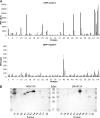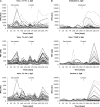Recombinant surface proteomics as a tool to analyze humoral immune responses in bovines infected by Mycoplasma mycoides subsp. mycoides small colony type
- PMID: 19696080
- PMCID: PMC2773720
- DOI: 10.1074/mcp.M900009-MCP200
Recombinant surface proteomics as a tool to analyze humoral immune responses in bovines infected by Mycoplasma mycoides subsp. mycoides small colony type
Abstract
A systematic approach to characterize the surface proteome of Mycoplasma mycoides subspecies mycoides small colony type (M. mycoides SC), the causative agent of contagious bovine pleuropneumonia (CBPP) in cattle, is presented. Humoral immune responses in 242 CBPP-affected cattle and controls were monitored against one-third of the surface proteins of M. mycoides SC in a high throughput magnetic bead-based assay. Initially, 64 surface proteins were selected from the genome sequence of M. mycoides SC and expressed as recombinant proteins in Escherichia coli. Binding of antibodies to each individual protein could then be analyzed simultaneously in minute sample volumes with the Luminex suspension array technology. The assay was optimized on Namibian CBPP-positive sera and Swedish negative controls to allow detection and 20-fold mean signal separation between CBPP-positive and -negative sera. Signals were proven to be protein-specific by inhibition experiments, and results agreed with Western blot experiments. The potential of the assay to monitor IgG, IgM, and IgA responses over time was shown in a proof-of-concept study with 116 sera from eight animals in a CBPP vaccine study. In conclusion, a toolbox with recombinant proteins and a flexible suspension array assay that allows multiplex analysis of humoral immune responses to M. mycoides SC has been created.
Figures





References
-
- . (2003) Contagious bovine pleuropneumonia. EMPRES transboundary. Animal Disease Bulletin 24, 2– 7
-
- Windsor R. S. (2000) The eradication of contagious bovine pleuropneumonia from south western Africa. A plan for action. Ann. N.Y. Acad. Sci 916, 326– 332 - PubMed
-
- Egwu G. O., Nicholas R. A. J., Ameh J. A., Bashiruddin J. B. (1996) Contagious bovine pleuropneumonia: an update. Vet. Bull 66, 875– 888
-
- Nicholas R., Bashiruddin J., Ayling R., Miles R. (2000) Contagious bovine pleuropneumonia: a review of recent developments. Vet. Bull 70, 827– 838
-
- Windsor R. S., Wood A. (1998) Contagious bovine pleuropneumonia. The costs of control in Central/southern Africa. Ann. N.Y. Acad. Sci 849, 299– 306 - PubMed
Publication types
MeSH terms
Substances
LinkOut - more resources
Full Text Sources
Other Literature Sources
Miscellaneous

